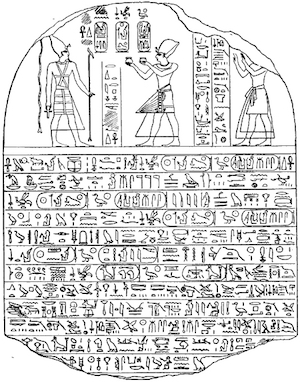The stele was established in Tanis during the reign of Ramesses II (New Kingdom). It refers to a 400 year anniversary event for the god Set which was arranged by Ramesses II’s father (Seti I) before he became king (during the reign of Horemheb). The extensive titles listed in the second paragraph relate to Seti. The text is adapted from Pritchard’s translation.

“Live the Horus: Mighty Bull, Who Loves Truth, (Ramsses II). His majesty commanded the making of a great stela of granite bearing the great name of his fathers, in order to set up the name of the father of his fathers (and of) the King Men-maat-Re, the Son of Re: Seti MerenPtah, (Seti I) and abiding forever like Re every day: Year 400, 4th month of the third season, day 4, of the King of Upper and Lower Egypt Set-the-Great-of-Strength, the Son of Ra, his beloved, The-Ombite, beloved of Ra-Herakhty, so that he exists forever and ever.
Now there came the Hereditary Prince; Mayor of the City and Vizier; Fan-Bearer on the Right Hand of the King, Troop Commander; Overseer of Foreign Countries; Overseer of the Fortress of Sile; Chief of Police, Royal Scribe; Master of Horse; Conductor of the Feast of the Ram-the-Lord-of-Mendes; High Priest of Set; Lector Priest of Uto, ‘She-Whe~Opens-the-Two-Lands’ and Overseer of the Prophets of all the Gods, Seti, the triumphant, the son of the Hereditary Prince; Mayor of the City and Vizier; Troop Commander; Overseer of Foreign Countries; Overseer of the Fortress of Sile; Royal Scribe; and Master of Horse, Pa-Ramses (Ramesis I), the triumphant, and child of the Lady of the House and Singer of the Ra, Tiu, the triumphant. He said: ‘Hail to you, Set, Son of Nut, the Great of Strength in the Barque of Millions, felling the enemy at the prow of the barque of Ra, great of battle cry… ! May [you] give me a good lifetime serving [your] ka, while I remain in [your favor] …'”
Bibliography
- Pritchard, James B (1969) Ancient Near Eastern Texts
Copyright J Hill 2016